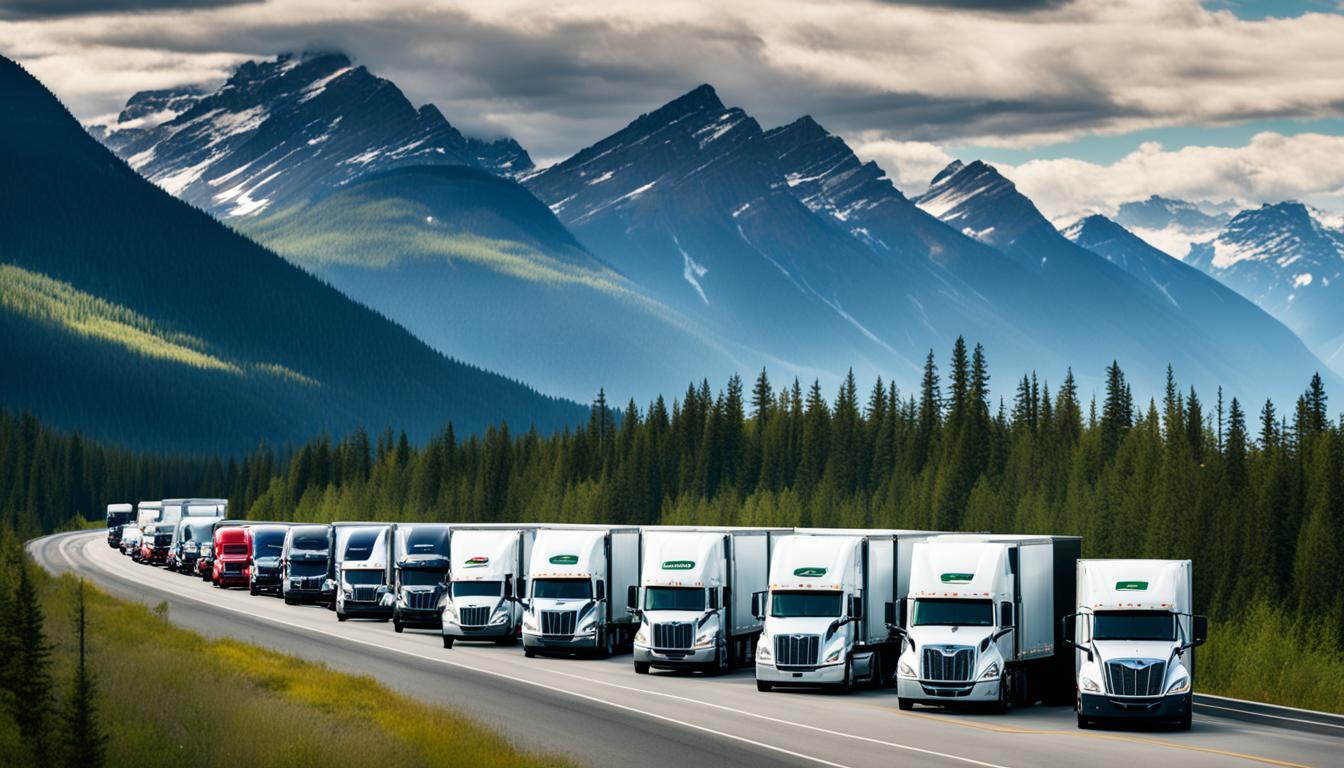Canada, a vast country known for its stunning landscapes and diverse culture, relies heavily on its transportation industry to keep goods moving. At the heart of this industry are the truckers, who tirelessly drive countless miles to ensure that products reach their destinations on time. But have you ever wondered how many truckers in Canada? And what is the demand for truckers in this country? Furthermore, what is the average pay for these hardworking individuals? In this article, we will explore the latest statistics and provide you with answers to these burning questions. So, get ready to delve into the world of trucking in Canada and gain a better understanding of this crucial sector of the nation’s economy.
Introduction to the Trucking Industry in Canada
The Canadian trucking industry is a vital component of the country’s transportation and logistics sector, playing a crucial role in the movement of goods and people across the nation. This industry comprises establishments primarily engaged in the truck transportation of merchandise, as well as a variety of transit and ground passenger transportation activities.
Significance of the Trucking Industry
The trucking industry is a significant contributor to Canada’s economy, providing essential services that support various sectors, including manufacturing, retail, and agriculture. This industry is responsible for the efficient and timely delivery of a wide range of products, ensuring that businesses and consumers have access to the goods they need.
Overview of the Trucking Industry Segments
The Canadian trucking industry encompasses several distinct segments, including freight transportation services and passenger transportation services. The freight transportation segment is the largest, accounting for the majority of the industry’s production and employment. This segment is responsible for the movement of goods and materials, ranging from raw materials to finished products, across the country and beyond.
The passenger transportation segment, on the other hand, focuses on the movement of people, providing transit and ground passenger transportation services to various communities and regions within Canada.
Employment Statistics in the Canadian Trucking Industry
The Canadian trucking industry is a significant contributor to the country’s workforce, employing over 500,400 workers in 2021. These employment statistics provide valuable insights into the size and composition of the trucking industry in Canada.
Number of Truckers in Canada
According to the latest data, the Canadian trucking industry employed over 500,400 workers in 2021, making it a substantial part of the country’s overall employment landscape. This figure highlights the vital role that truckers play in the transportation and logistics sector, connecting communities and businesses across the nation.
Regional Distribution of Truckers
The distribution of truckers in Canada varies across different regions, reflecting the diverse economic activities and transportation needs of the country. Major provinces like Ontario, Quebec, and British Columbia have the highest concentrations of truck driver employment, while other regions, such as the Prairies and the Maritimes, also contribute significantly to the overall trucking workforce.

How Many Truckers in Canada?
The Canadian trucking industry employs a diverse workforce, with a range of occupational categories and a predominance of male workers. According to the latest data, there are over 500,400 truckers and other transportation workers in Canada, making it a significant contributor to the country’s economy.
Breakdown by Occupational Categories
Within the trucking industry, the occupational breakdown includes heavy truck and tractor-trailer drivers, light duty truck drivers, delivery and courier service drivers, and various other transportation-related roles. This diverse mix of occupations highlights the breadth of the industry and the wide range of skills and responsibilities required to keep the Canadian supply chain moving.
Gender Composition of the Workforce
The trucking industry in Canada is predominantly male-dominated, with over 90% of the workforce being men. This gender disparity reflects the historical and societal perceptions of the industry, as well as the physical demands and long hours associated with many trucking-related jobs. However, efforts are underway to attract more women to the profession and create a more diverse and inclusive workforce in the Canadian trucking industry.
The demographics of the Canadian trucking industry showcase the significant role that truck drivers and other transportation workers play in the country’s economy. With a predominantly male-dominated workforce and a range of occupational categories, the industry continues to evolve to meet the growing demand for transportation services across Canada.
Impact of COVID-19 on the Trucking Industry
The COVID-19 pandemic had a profound impact on the Canadian trucking industry, with a dramatic decline in output and employment levels across the sector. As the pandemic disrupted global supply chains and economic activity, the trucking industry faced a multitude of challenges that tested its resilience.
Decline in Output and Employment
The trucking industry in Canada experienced a significant decline in output and employment during the COVID-19 pandemic. Many businesses and industries were forced to scale back operations or temporarily close, leading to a sharp drop in the demand for freight transportation services. This, in turn, resulted in a decline in trucking output and employment as companies adjusted to the changing market conditions.
Challenges Faced by the Industry
The challenges faced by the trucking industry during the pandemic were multifaceted. Strict public health measures, such as lockdowns and border closures, disrupted the flow of goods and hampered the ability of truckers to perform their duties efficiently. Additionally, the industry faced issues related to supply chain disruptions, reduced freight volumes, and financial pressures as businesses struggled to adapt to the rapidly changing environment.
The impact of COVID-19 on the Canadian trucking sector was significant, as the industry had to navigate through a complex and ever-evolving landscape to maintain operations and service the changing needs of its customers. The pandemic’s effects on the trucking industry underscored the critical role that this sector plays in the Canadian economy and the need for robust strategies to support its resilience in times of crisis.

Factors Influencing the Demand for Truckers
The demand for truckers in Canada is influenced by a complex interplay of economic, trade, urbanization, and transportation infrastructure factors. As the country’s economy grows and trade activities expand, the need for efficient freight transportation services intensifies, directly impacting the demand for skilled truck drivers.
Economic Growth and Trade Activity
Canada’s strong economic performance and its active involvement in global trade networks are key drivers of the increasing demand for truckers. As the economy expands and the volume of goods being transported domestically and internationally rises, the trucking industry must adapt to meet the surge in freight transportation needs. The role of trade activity, such as the country’s participation in international trade agreements and the growth of import-export operations, is particularly influential in shaping the demand for truck drivers in Canada.
Urbanization and Public Transit Investments
The trend of urbanization in Canada, with more people living in urban centers, has also influenced the demand for truckers. As cities grow and the need for efficient goods delivery to population hubs increases, the trucking industry plays a crucial role in meeting this rising urban logistics demand. Additionally, the government’s investments in public transit infrastructure, such as the expansion of bus and light rail services, can indirectly impact the trucking industry by altering the flow of passenger and freight transportation within and between urban areas.
Future Outlook for the Trucking Industry
The future outlook for the Canadian trucking industry points to a promising recovery and growth, driven by various factors that are expected to shape the sector’s trajectory in the coming years. Key indicators suggest a positive forecasted growth in trucking output and employment within the country.
Projected Growth in Output and Employment
Industry experts project a steady increase in the output and employment levels of the Canadian trucking industry in the near future. As the economy continues to rebound from the COVID-19 pandemic, the demand for freight transportation and logistics services is anticipated to rise, fueling growth in the trucking sector. Additionally, factors such as urbanization and public transit investments are expected to contribute to the industry’s expansion, as the movement of people and goods becomes increasingly vital to meet the needs of growing urban centers.
Technological Advancements and Productivity Gains
The Canadian trucking industry is also poised to experience significant productivity gains driven by the impact of technology on various aspects of the sector. The adoption of advanced technologies, such as telematics, automation, and data analytics, is expected to enhance the efficiency and cost-effectiveness of trucking operations. These technological advancements will likely lead to improved fleet management, enhanced safety, and reduced operating expenses, ultimately contributing to the overall productivity gains in the Canadian trucking industry.
As the industry navigates the projected changes in the trucking industry in Canada, it will be crucial for stakeholders to adapt to these emerging trends and capitalize on the opportunities presented by the industry’s promising future outlook.

Labour Shortages and Recruitment Challenges
The Canadian trucking industry faces significant labour shortages and recruitment challenges, driven by an aging workforce and the demanding working conditions associated with many trucking-related occupations. As the country’s trucking companies struggle to attract and retain qualified drivers, this issue has become a growing concern for the industry.
Aging Workforce and Retirement Patterns
One of the primary factors contributing to labour shortages in the Canadian trucking sector is the aging of the workforce. The average age of truck drivers in Canada is 47 years, with a significant portion of the workforce nearing retirement age. As experienced truck drivers retire, the industry is faced with the challenge of replacing them with a younger generation of workers, a task that has proven increasingly difficult in recent years.
According to industry data, the retirement patterns of truck drivers in Canada are expected to accelerate in the coming years, further exacerbating the labour shortage. This demographic shift, coupled with the physical demands of the job, has made it challenging for trucking companies to maintain a stable and reliable workforce.
Working Conditions and Retention Strategies
The demanding nature of the trucking profession, including long hours, irregular schedules, and extended periods away from home, has also contributed to the industry’s recruitment and retention challenges. Many potential candidates are deterred by the working conditions, leading trucking companies to explore various strategies to improve employee satisfaction and reduce turnover.
Trucking companies in Canada are increasingly recognizing the need to offer competitive compensation packages, more flexible work arrangements, and improved benefits to attract and retain drivers. Additionally, investments in training and development programs, as well as initiatives to enhance the overall work environment, have become essential components of the industry’s efforts to address the labour shortage.
Government Policies and Regulations
The Canadian trucking industry is influenced by various government policies and regulations, particularly those related to environmental concerns and infrastructure investments. These policies and initiatives can have a significant impact on the operations and profitability of trucking companies in the country.
Carbon Pricing and Environmental Regulations for Trucking
The Canadian government has implemented carbon pricing and other environmental regulations that aim to reduce greenhouse gas emissions across various sectors, including the trucking industry. These policies, such as the federal carbon tax and provincial carbon pricing schemes, have increased the operational costs for trucking companies, as they must now factor in the additional expenses associated with their fuel consumption and emissions. Trucking companies are challenged to adapt their operations and invest in more fuel-efficient or alternative-fuel vehicles to comply with these regulations and remain competitive.
Impact of Infrastructure Investments on Trucking Sector
Governments in Canada have made significant investments in transportation infrastructure, including the construction and maintenance of highways, bridges, and other critical assets used by the trucking industry. These infrastructure projects can have a direct impact on the efficiency and productivity of the trucking sector, as improved roads, bridges, and transportation networks can reduce travel times, fuel consumption, and overall operating costs for trucking companies. Additionally, public transit initiatives, such as the expansion of commuter rail and bus services, can influence the demand for trucking services, as they may alter the flow of goods and passenger traffic in urban areas.

Emerging Trends and Disruptive Technologies
The Canadian trucking industry is witnessing the emergence of various trends and disruptive technologies that are shaping the future of the sector. Among the most notable developments are the increasing adoption of autonomous vehicles and driverless trucks, as well as the growing role of ride-sharing services in the transportation ecosystem.
Autonomous Vehicles and Driverless Trucks
The impact of autonomous vehicles and driverless trucks is expected to be transformative for the Canadian trucking industry. These emerging autonomous vehicle technologies have the potential to enhance productivity, improve safety, and reduce labour costs associated with the future of driverless trucks in Canada. As the industry continues to grapple with the truck driver shortage in Canada, the rise of autonomous vehicles on the trucking industry could reshape the workforce and operational models of transportation companies across the country.
Ride-Sharing Services and their Impact
The role of ride-sharing services in the trucking sector is also garnering attention, as platforms like Uber Freight and other disruptive technologies in the Canadian transportation industry aim to optimize freight logistics and the movement of goods. These emerging trends in the Canadian trucking industry are poised to have a significant impact on traditional trucking operations, potentially disrupting established practices and creating new opportunities for collaboration and innovation.
Conclusion
In conclusion, the Canadian trucking industry is a crucial component of the country’s transportation and logistics sector, employing over 500,400 workers in 2021 and playing a vital role in the movement of goods and people across the nation. This industry has faced significant challenges during the COVID-19 pandemic, with a decline in output and employment levels, as well as various operational obstacles.
However, the future outlook for the Canadian trucking industry points to a promising recovery and growth, driven by factors such as economic expansion, increased trade activity, urbanization, and investments in public transit infrastructure. The industry is also set to benefit from technological advancements, which are expected to drive productivity gains and enhance the overall efficiency of the sector.
While the industry continues to grapple with labour shortages and recruitment challenges, particularly due to an aging workforce and demanding working conditions, government policies and regulations aimed at addressing environmental concerns and infrastructure development are poised to shape the future of the Canadian trucking industry. As the country continues to evolve, the trucking sector will undoubtedly play a crucial role in supporting economic growth, trade, and the seamless movement of goods and people across the nation.
FAQ
1. How many truckers are there in Canada?
According to the latest data from Statistics Canada, the Canadian trucking industry employed over 500,400 workers in 2021, making it a significant contributor to the country’s workforce.
2. Who is the largest trucking company in Canada?
The Canadian trucking industry is highly fragmented, with no single dominant player. The industry comprises a mix of small, medium, and large trucking companies, with the largest companies being national or multinational logistics providers.
3. Are truckers in high demand in Canada?
Yes, the demand for truckers in Canada is influenced by a variety of factors, including economic growth, trade activity, urbanization, and public transit investments. The Canadian trucking industry faces significant labour shortages and recruitment challenges, driven by an aging workforce and the demanding working conditions associated with many trucking-related occupations.
4. How much do truckers get paid in Canada?
The average salary for truck drivers in Canada can vary depending on factors such as the type of driving, experience, and location. According to data from JobBank Canada, the average hourly wage for truck drivers in Canada ranges from to per hour, with the potential for higher earnings for long-haul or specialized driving positions.
5. Who is the highest paying trucking company in Canada?
There is no single highest paying trucking company in Canada, as salaries can vary based on a variety of factors. Top-paying trucking companies in Canada tend to be large national or multinational logistics providers that offer competitive compensation and benefits packages to attract and retain skilled drivers.
6. Which country pays truck drivers the most?
Among developed countries, Norway, Switzerland, and the United States tend to have the highest average salaries for truck drivers. However, it’s important to consider factors such as cost of living, benefits, and overall compensation packages when comparing truck driver salaries across different countries.




